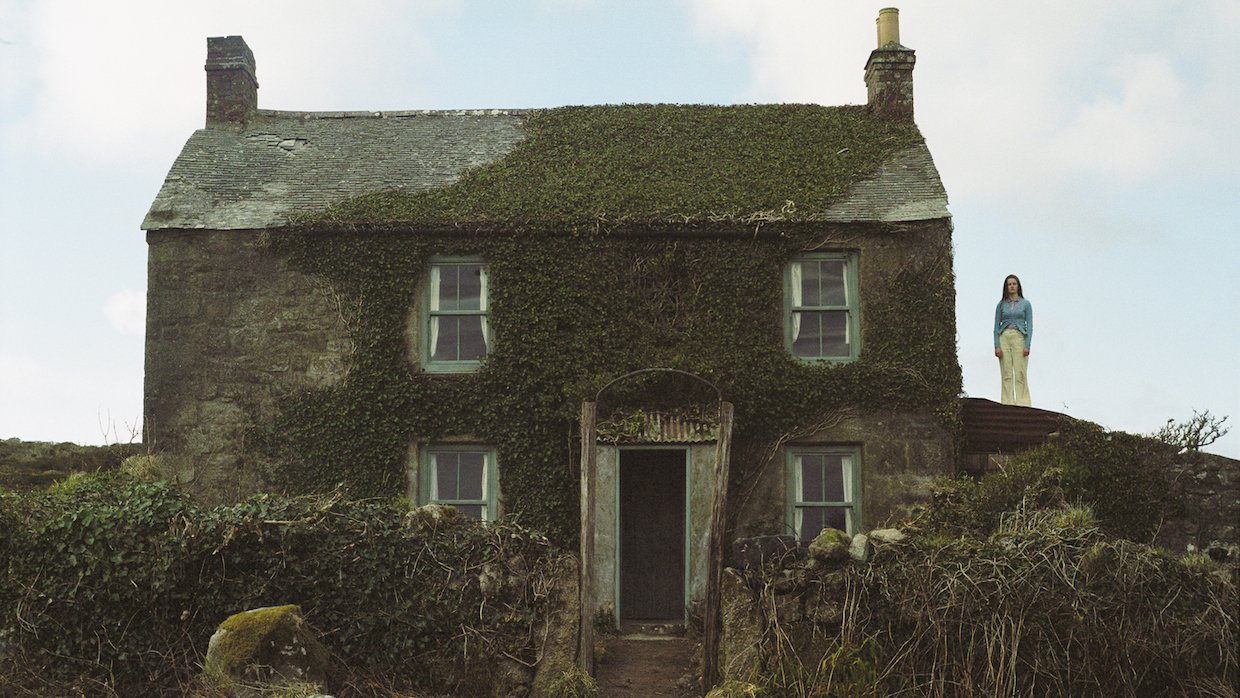ENYS MEN: Buried by Time and Lichen
A mainstay of British cinema in the 1970s, the folk horror genre has seen a resurgence in recent years, with works as disparate as Ben Wheatley’s psychedelic A Field In England and Alex Garland’s body-horrific Men. Director Mark Jenkin, perhaps best known for his music videos for Radiohead offshoot The Smile, contributes his unique vision to the genre with the oblique but deeply felt Enys Men.
Jenkin is a native of Cornwall, a coastal area of England with a distinct language and culture, and his film is steeped in its regional affect. Set in the spring of 1973, Enys Men follows a middle-aged woman known only as The Volunteer staying on the titular stone island for a botanical research project.
The Volunteer follows a curious schedule of tasks with hypnotic precision. She tracks the growth of a sprig of white flowers springing from the inhospitable soil; drops a rock down a deep and forebodingly dark mineshaft; fixes tea while listening to a transistor radio; and writes perfunctory entries in her biology notebook. She seems quite content in her solitude, but naturally things are not what they seem.
Jenkin arranges his compositions in the square-ish aspect ratio that was industry standard in the silent era and has recently come back into fashion (see The Lighthouse). An acolyte of the 16mm wind-up Bolex camera, Jenkins creates painstakingly oversaturated images which have a timeless, almost supernatural quality. The film looks as if it were dug up from a rusty trunk at the bottom of the sea.
The sound design is saturated as well, textured with the granular crackle of the radio, the sharp rattle of a petrol generator. Since the hand-wound camera precludes live recording, everything we hear is overdubbed, creating an uncanny separation between sound and image. In the few scenes where characters speak, their voices sound as if they’re stretching across a transatlantic phone line. A seagull diving below the waves for a snack is paired with the crash of breaking glass.
The film abounds with examples of the futile human drive to constrain nature. The Volunteer finds a set of trolley tracks completely buried by weeds. The house she inhabits is covered in moss and windswept to the point that it resembles part of the rocky cliffs. The locations are trippy special effects in themselves, real Black Sabbath-album-cover stuff.
It takes awhile for anything weird to happen—the hypnotic pace generates a great deal of tension but threatens to stagnate during the opening act. Suddenly, characters that may or may not be there begin appearing around the house, particularly a young girl in a vivid blue dress (in sharp counterpoint to the Volunteer’s scarlet-red windcheater). Was she there all along? Is she a daughter, or an apparition from a past life? Time begins to refract—waves shrink in on themselves, water drips upward. A druid monolith inches closer to the house until it fills the doorframe.
Actress Mary Woodvine (Jenkin’s partner) carries the film as the enigmatic Volunteer. A performer of intense presence, Woodvine imbues her character with hard-earned pathos and rich interiority as she traipses around the island staring at lichen. Jenkins risks losing her in abstraction, but gradually an image comes into focus: the disintegration of a family, a community, an individual psyche lost in the wilderness.
The film leaves more questions than answers, which seems part of its grand design. One clue points toward a more definitive analysis: in several scenes, the Volunteer reads a tattered paperback called “A Blueprint For Survival.” A quick Google search confirms this is a real book, published in the early 1970s, which proselytizes the breakup of globalized society and a return to small agrarian communities to prevent ecological disaster. But would we reap any benefit by returning to such a life? The Volunteer finds little comfort in the entropy she witnesses in this unforgiving landscape, or the spiritual aftermath of the natural disasters that befell the island’s previous inhabitants.
Despite what the marketing department would have us believe, the film is neither a wild head-fuck nor a transgressive pagan horrorfest. Instead, Jenkins crafts a remarkably tactile vision of the natural elements constantly breaking down our human drive to forge order and meaning from the chaos. If one could turn a Boards of Canada album into a movie, it would look something like Enys Men: an intriguing portrait of a world defined by rust, wind, water and moss, suffused with nostalgia and fixated on its own unhurried analog technique.




Matthew K. Seidel is a writer and musician living in Austin since 2004. The above selfie was taken in an otherwise empty screening of Heat at 10:30 in the morning. You can find him on Letterboxd @tropesmoker.